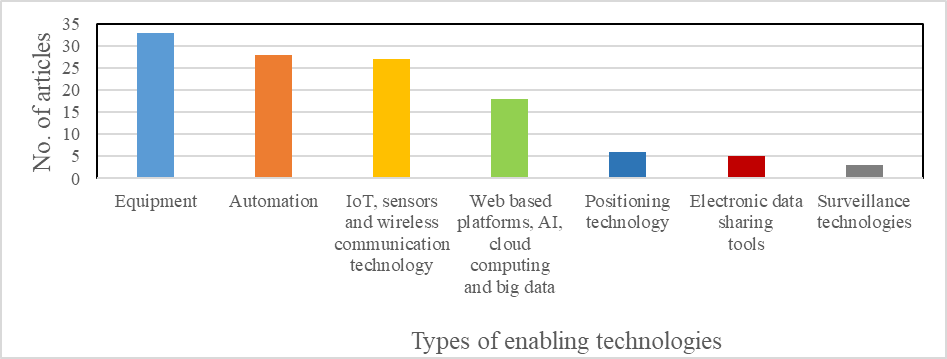Enabling technologies have wide application in intermodal freight transport (IFT). Their application is observed on components of IFT including, in ports, terminals, transport services, and loading units. Several enabling technologies such as wireless communication technology, sensors, positioning technology, and web-based platforms are highly utilized in intermodal freight transport globally. In contrast, electronic data interchange (EDI), wireless communication technologies, and web-based platforms also have potential applications in low-income countries, and their adoption should be studied further.
- intermodal freight transport
- ICT
- digitalization
- automation
- low-income countries
1. Introduction
2. Enabling Technologies and Their Applications in Developed Countries
2.1. Applications of Enabling Technologies
2.1.1. Equipment
2.1.2. Automation
2.1.3. Web-Based Platforms, Artificial Intelligence (AI), Cloud Computing, and Big Data
2.1.4. Internet of Things (IoT), Sensors, and Wireless Communication Technologies
2.1.5. Positioning Technologies
2.1.6. Electronic Data-Sharing Tools

Figure 1. Enabling technologies applied in intermodal freight transport discussed with the articles.
Table 1. Application of technologies on different components of intermodal freight transport.
|
Enabling Technologies |
Components of Intermodal Transport |
||||
|
Ports and Terminals |
Chain Management and Monitoring |
PPH |
Main Haulage |
Load Unit |
|
|
Automation |
|
* |
Collect automatic data from port operators, logistic providers and carriers for an excellent decisions support system Automated trucks and platoon operations work to reduce road congestion, environmental impact and improve safety |
Autonomous underground transport and ships provide a fast and reliable service |
* |
|
IoT, sensors, and wireless communication technology |
Provides automatic identification of units at gates, security of containers and real-time tracking and tracing in ports Optimize port call |
Ensure security of cargo by sending signals for risk conditions and safety of perishable products Optimize mode choice using real-time data |
Used for the efficient port calling process Provide real-time information from trucks to stakeholders |
Monitor vibration during transportation and report for anticipated risk |
* |
|
Web-based platforms, AI, cloud computing, and big data |
Broadcast schedules in port Clear presentation of required information and procedures to stakeholders |
Used to select the best chain in choosing transport service Enable fast and reliable decision support system Provide visibility of goods in transport |
Provide a decision support system for logistics providers Establish collaboration between carriers to reduce empty running Online matching between shipping request and service |
Easy access to information of the status of the long-haul vehicle to stakeholders |
Provide centralized and fast container booking system |
|
Positioning technology |
Used to locate trucks, containers, and equipment in ports for efficient work planning |
Ensures traceability by locating the cargo throughout the chain |
Identifies the real-time location of trucks Used to determine shortest path routes |
Provides real-time location of cargo while in the main haulage (e.g., a location where any mishandling of good occur) |
* |
|
Electronic data-sharing tools |
Provide easy and quick port administration in port calling, customs declaration, clearance notification Port-EDI for a one-stop service (single window) |
n/a |
Exchange booking and boarding instructions between consignee and freight forwarders |
Information about the position of ships |
n/a |
|
Surveillance technology |
Ensures the safety of cargo under port process Identifies plate numbers of trucks entering port |
Ensures cargo safety throughout the chain |
Controls security of cargo and drivers in inland transport |
* |
Automatic extraction of container identity code |
* No article found. “n/a” not applied.
2.2. Pre-Conditions and Barriers for Implementation of Technologies in IFT
3. Applications of Enabling Technologies in IFT for Low-Income Countries
3.1. Characterization of IFT in Low-Income Countries
Low-income countries have limited infrastructures, including low road densities and limited quality of road infrastructure [28]. Therefore, some technologies cannot be successfully implemented. Road and rail connectivity are also very poor in these countries [9,29,30]. This has resulted in the low utilization of railroad intermodal transport.
3.2. Enabling Technologies with Potential Applications in Low-Income Countries
3.2.1. Ports and Terminals
3.2.2. Chain Management and Monitoring
3.2.3. Pre and Post-Haulage
3.2.4. Main Haulage
This entry is adapted from the peer-reviewed paper 10.3390/futuretransp2010003
